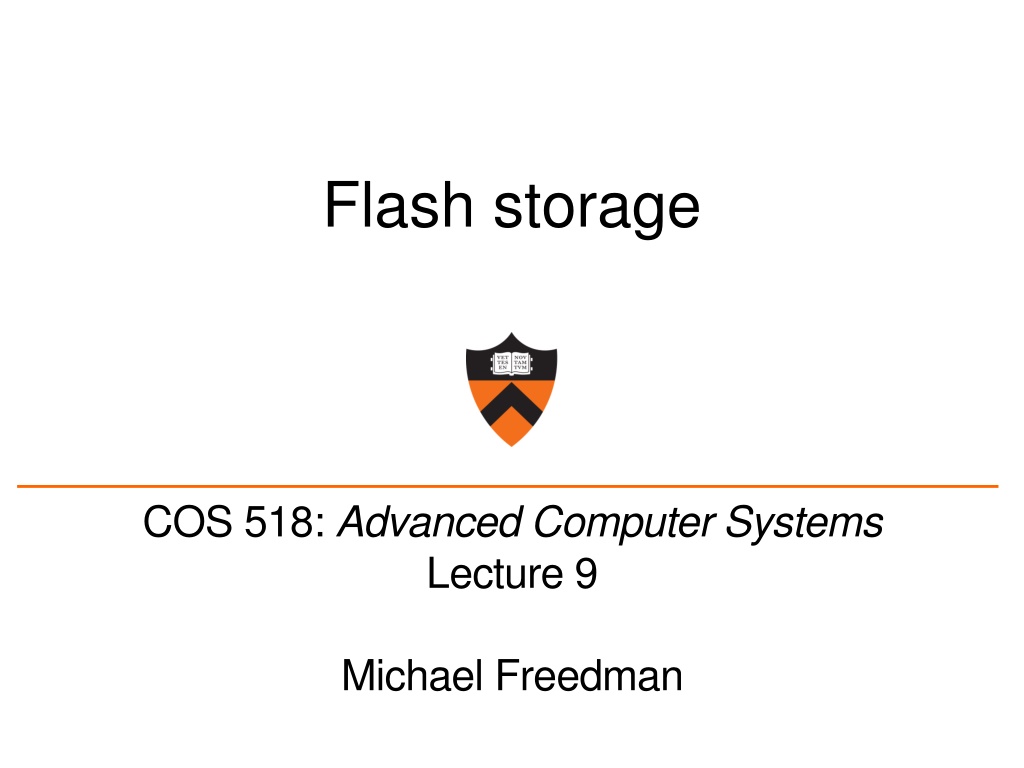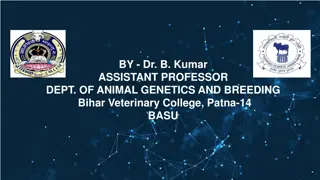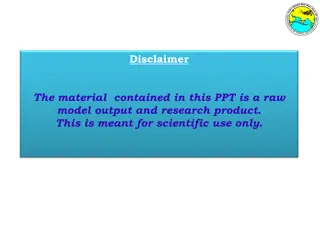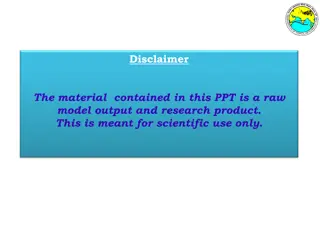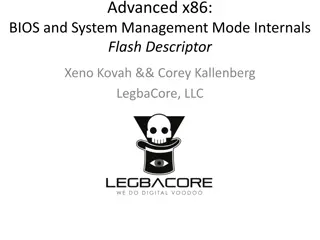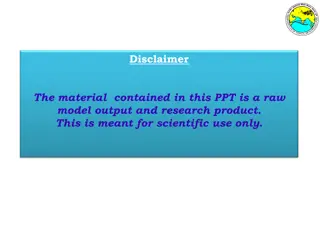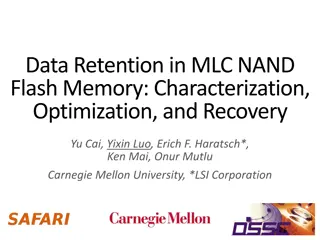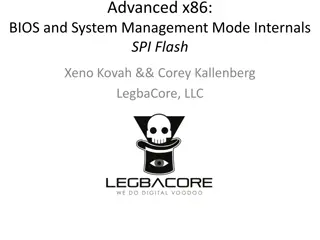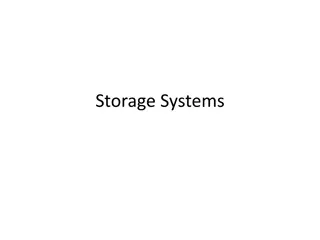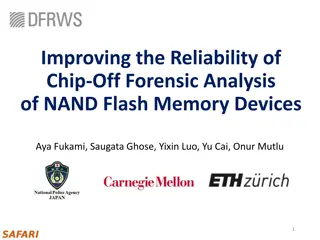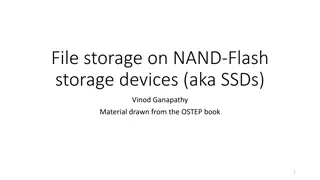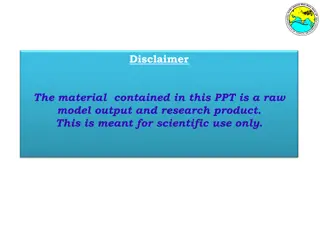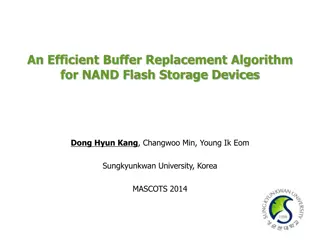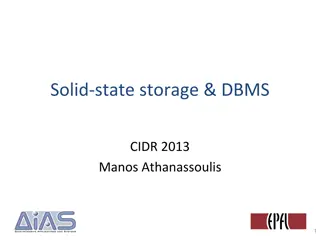Flash Storage Optimization Techniques in Advanced Computer Systems
Lecture 9 by Michael Freedman covers advanced concepts in flash storage, comparing HDD and SSD performance, suggesting solutions for write-heavy workloads, and exploring innovations in flash memory technology like storing individual bits and managing threshold voltages.
Download Presentation

Please find below an Image/Link to download the presentation.
The content on the website is provided AS IS for your information and personal use only. It may not be sold, licensed, or shared on other websites without obtaining consent from the author. Download presentation by click this link. If you encounter any issues during the download, it is possible that the publisher has removed the file from their server.
E N D
Presentation Transcript
Flash storage COS 518: Advanced Computer Systems Lecture 9 Michael Freedman
~2016 Seagate ($50) 1TB HDD 7200RPM Model: STD1000DM003-1SB10C Operation Sequential Read Sequential Write Random Read 4KiB HDD Performance 176 MB/s 190 MB/s 0.495 MB/s 121 IOPS 0.919 MB/s 224 IOPS Random Write 4KiB DQ Random Read 4KiB 1.198 MB/s 292 IOPS 0.929 MB/s 227 IOPS DQ Random Write 4KiB http://www.tomshardware.com/answers/id-3201572/good-normal-read-write-speed-hdd.html 2
~2016 Seagate ($50) 1TB HDD 7200RPM Model: STD1000DM003-1SB10C Samsung ($330) 512 GB 960 Pro NVMe PCIe M.2 Model: MZ-V6P512BW Operation Sequential Read Sequential Write Random Read 4KiB HDD Performance SSD Performance 176 MB/s 190 MB/s 0.495 MB/s 121 IOPS 0.919 MB/s 224 IOPS 2268 MB/s 1696 MB/s 44.9 MB/s 10,962 IOPS 151 MB/s 36,865 IOPS Random Write 4KiB DQ Random Read 4KiB 1.198 MB/s 292 IOPS 0.929 MB/s 227 IOPS 348 MB/s 84961 IOPS 399 MB/s 97,412 IOPS DQ Random Write 4KiB http://www.tomshardware.com/answers/id-3201572/good-normal-read-write-speed-hdd.html http://ssd.userbenchmark.com/SpeedTest/182182/Samsung-SSD-960-PRO-512GB 3
Idea: Traditionally disks laid out with spatial locality due to cost of seeks Observation: main memory getting bigger most reads from memory Implication: Disk workloads now write-heavy avoid seeks write log New problem: Many seeks to read, need to occasionally defragment New tech solution: SSDs seeks cheap, erase blocks change defrag 4
Threshold Voltage (Vth) Flash cell Flash cell Flash cell Flash cell 0 1 Normalized Vth 6
Threshold Voltage (Vth) Distribution Probability Density Function (PDF) 0 1 Normalized Vth 7
Read Reference Voltage (Vref) Probability Density Function (PDF) Vref 0 1 Normalized Vth 8
Multi-Level Cell (MLC) Erased (11) P1 (10) P2 (00) P3 (01) Normalized Vth 9
Flash: Bit vs. page-level access NOR flash Cells connected in parallel to bit lines Cells can be read and written to individually NAND flash Cells connected in series, consuming less space Smaller area needed to implement certain capacity Reduce cost per bit, increase max chip capacity Cells can only be written and read at the page level 11
NAND Flash: Architecture Architecture: Pages: 8-16 KB, assembled into Blocks: 4-8 MB 12
NAND Flash: Reading / writing Always read an entire page: Can only read entire aligned page from SSD Always write an entire page: To change single byte, need to write entire page Pages cannot be overwritten Page can be written only if the free state. Updating: Read page to internal register, modify, then write to free page Erases are aligned on block size To make a page free , need to erase it Erasures can only occur at block boundary 13
Why Erase then Write? Hardware limitation A freshly erased, blank page of NAND flash has no charged gates; it stores all 1s. 1s can be turned into 0s at the page level, but one- way process. Turning 0s back into 1s is a difficult operation b/c it uses high voltages. Difficult to confine the effect only to desired cells; high voltages can change adjacent cells.
Implication: Buffer small writes To maximize throughput: Keep small writes into a buffer in RAM Perform large batch write when buffer full Suited well for log-structured write (e.g., LSM trees) 15
SSD: Solid State Driver Host Interface Logic SSD Controller RAM Buffer Flash Memory Package
SSD: Solid State Driver Host Interface Logic SSD Controller RAM Buffer Flash Memory Package
Last twist Disk lifetime: each page can only be written some fixed number of times: SLC: 100,000 P/E cycles MLC: 3,000 P/E cycles TLC: 100 P/E cycles When blocks get bad, take them out of rotation Need indirection layer to not use bad pages Want to load balance writes over pages! FTL: Flash-Translation Layer for wear leveling 19
